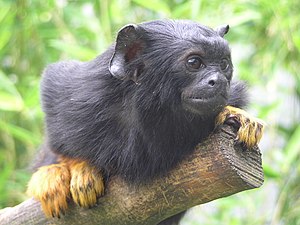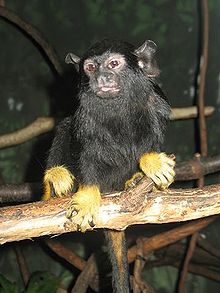Red-hand tamarin
| Red-hand tamarin | ||||||||||||
|---|---|---|---|---|---|---|---|---|---|---|---|---|

Red-hand Tamarin ( Saguinus midas ) |
||||||||||||
| Systematics | ||||||||||||
|
||||||||||||
| Scientific name | ||||||||||||
| Saguinus midas | ||||||||||||
| ( Linnaeus , 1758) |
The red-hand tamarin ( Saguinus midas ) is a species of primate from the genus group of the tamarins , which belongs to the family of marmosets (Callitrichidae). The black-hand tamarin , which was previously listed as a subspecies of the red-hand tamarin, is now considered a separate species.
description
The fur of the red-hand tamarins is dark brown or black, the name-giving feature is the reddish-yellow front and rear paws. The dark face is hairless, the large ears protrude from the fur. As with all marmosets, the fingers and toes (with the exception of the big toe) have claws instead of nails. These animals reach a head body length of 21 to 28 centimeters, the tail is 31 to 44 centimeters long. The weight is around 400 to 550 grams.
distribution and habitat
Red-hand tamarins are native to northeastern South America, their range includes Guyana , Suriname and French Guyana as well as northeastern Brazil north of the Amazon . Their habitat is forests, although they prefer forest forms with dense undergrowth.
Way of life
Like all marmosets, these primates are diurnal. They usually stay in the trees, where they move on all fours or jumping. They live in groups of two to six, in exceptional cases up to 15 animals. These groups consist of a dominant female, possibly further, subordinate females, one or more males and the common offspring. The social behavior is very pronounced, within the group there is hardly any aggression, even among the males, grooming and a series of sounds serve for communication and interaction.
Red-hand tamarins are omnivores, their diet consists of fruits, insects and tree sap.
Reproduction
As with all tamarins, only the dominant female of the group reproduces and mates with all males in the group, a phenomenon rare among mammals known as polyandry . Twins are usually born after a gestation period of around 140 to 145 days. The rearing of the offspring is mainly the responsibility of the males, they carry the children around and only bring them to the female to suckle. Young animals are weaned at around two to three months and sexually mature at 16 to 20 months.
threat
Red-hand tamarins are adaptable and can also live near human settlements. They are rarely hunted and have a large range. For these reasons, the IUCN lists it as not at risk ( least concern ).
literature
- Thomas Geissmann : Comparative Primatology. Springer-Verlag, Berlin a. a. 2003, ISBN 3-540-43645-6 .
- Ronald M. Nowak: Walker's Mammals of the World. 6th edition. Johns Hopkins University Press, Baltimore MD 1999, ISBN 0-8018-5789-9 .
